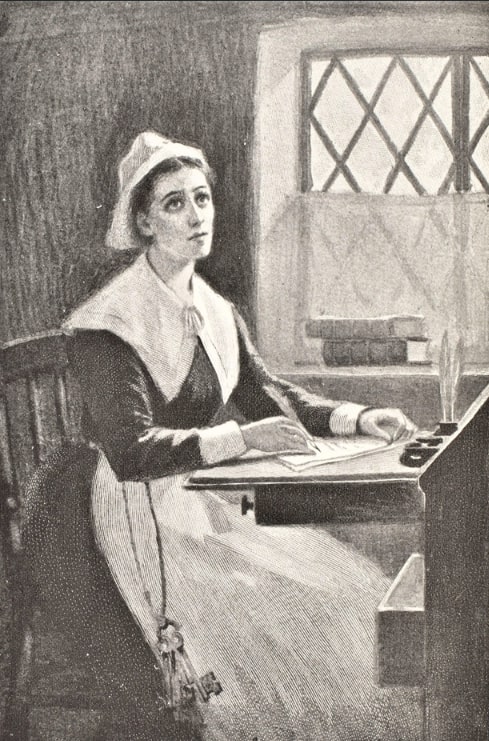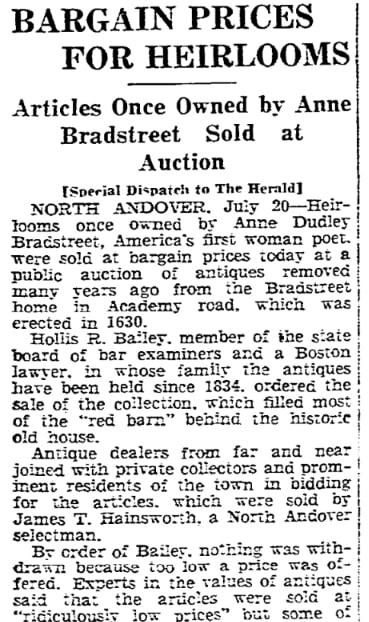Introduction: In this article, Melissa Davenport Berry writes about Anne Dudley Bradstreet, America’s first woman poet, who arrived in 1630. Melissa is a genealogist who has a blog, AnceStory Archives, and a Facebook group, New England Family Genealogy and History.
Today I pay homage to Anne Dudley Bradstreet (1612-1672), mother, author, wife, and “Empress Consort of Massachusetts.”
Now say, have women worth, or have they none?
Or had they some, but with our Queen is’t gone?
Nay Masculines, you have thus tax’d us long;
But she, though dead, will vindicate our wrong.
Let such as say our sex is void of reason
Know ’tis a slander now, but once was treason.–“In Honour of That High and Mighty Princess, Queen Elizabeth,” by Anne Dudley Bradstreet

The above lines crafted by Bradstreet were written about the late Queen Elizabeth I.
According to Ann Woodlief, Bradstreet approached “feminist” views with humor when responding to those Puritans who felt women should be silent, modest, and living in the private rather than the public sphere – and the poem above is a good example of how this poetess handled her Puritan patriarchs.
In an article published by the Kalamazoo Gazette in 1895, Anne is described as “One of these ‘illuminated Christians.’”

This article reported:
…Anne Dudley Bradstreet, the friend and ship companion of the ill-fated Lady Arbella Johnson, who died so soon after her arrival in Salem [in 1630]. This Anne Bradstreet was New England’s first writer of verse who made old Ipswich the birthplace of American poetry. She was the wife of Governor Simon Bradstreet, and they lived on High Street near the Burial Hill. The first farm laid out in the early township of Ipswich – New Meadows, now Topsfield – was the one given by Gov. Bradstreet to his son Simon, whose descendants bearing the name of Bradstreet occupy an old-fashioned homestead close to the original one of 1635. It is said that while Anne Dudley, the poet wife of Gov. Bradstreet, has transmitted her genius to some of her descendants, among whom are Oliver Wendell Holmes and Richard H. Dana, the benevolent features and amicable characteristics of her husband, the old colonial governor, can be easily traced in some of his descendants in the village. She was the daughter of that rigid old Puritan, Gov. Thomas Dudley [and his wife Dorothy Yorke], and every generation since her time has had a Dudley Bradstreet, even to the present occupant of the hill farm on old Ipswich River.
And there are some who were named after the famed fem bard; among them, Annie Dudley Bradstreet, born to Grover Cleveland Bradstreet, who married Thomas Richard Armacker in 1968.
In 1901 Miss Esther Stuffins published an essay “Literary Women of Colonial Times” that won a medal from the Society of the Daughters of the American Revolution. The Evansville Courier printed a copy.

In her essay, Stuffins noted that Anne Dudley Bradstreet paved the way for future women writers and provided some background.
She wrote:
Very little is known of her early life, but judging from her writings she must have had several afflictions, for at the age of 19 she wrote:
“Twice ten years not fully told since nature gave me breath,
My race is run, my thread is spun, lo, here is fatal death.”Some years later Miss Dudley married Simon Bradstreet, and to them were born eight children, of whom Mrs. Bradstreet speaks in one of her poems as “Eight birds hatched in one nest.”
Mrs. Bradstreet’s poems were published in London in 1650 under the title of “The Tenth Muse Lately Sprung Up in America.” Her verses are distinguished by a great amount of curious and exact learning and are set forth with singular quaintness. The poems entitled “The Simple Cobbler of Agawam” and “Contemplations” are the most worthy of note.
Mrs. Bradstreet died in 1672, having prepared the way for the first great feminine author of the eighteenth century, Mercy Otis Warren.
Although Bradstreet’s exact grave is unknown, a commemorative marker was placed at an old burial ground in North Andover two decades ago. The area where Anne is buried is dubbed “The Valley of the Poets.”

The marker reads:
Mirror of her age, glory of her sex, whose Heaven-born soul leaving its earthly shrine, chose its native home, and was taken to its rest, upon 16th Sept. 1672. –John Norton Jr., 1672
I was searching for relics associated with Bradstreet and came across this announcement in the Boston Herald which was a bit surprising. Bradstreet’s heirlooms were sold for pennies on the dollar to antique dealers and collectors by some strange circumstances.

This article reported:
Heirlooms once owned by Anne Dudley Bradstreet, America’s first woman poet, were sold at bargain prices today at a public auction of antiques removed many years ago from the Bradstreet home in Academy Road, which was erected in 1630.
Hollis R. Bailey, member of the state board of bar examiners and a Boston lawyer, in whose family the antiques have been held since 1834, ordered the sale of the collection, which filled most of the “red barn” behind the historic old house.
Antique dealers from far and near joined with private collectors and prominent residents of the town in bidding for the articles, which were sold by James T. Hainsworth, a North Andover selectman.
By order of Bailey, nothing was withdrawn because too low a price was offered. Experts in the values of antiques said that the articles were sold at “ridiculously low prices” but some of the local residents who are amateurs in appraising heirlooms dating back to long before the Revolution expressed the opinion that the prices were too high “for such old stuff.”
It was the aim of Mr. Bailey to dispose of the entire collection and when Hainsworth took down his red flag, nothing resembling an antique remained unsold.
Hollis Russell Bailey, the son of Otis Bailey and Lucinda Alden Loring, grew up in the historic house. He died in Boston after a long illness the same year as the auction. This house, once believed to be Bradstreet’s home, was discovered to be the Parson Barnard House.
Recommended reading: “Mistress Bradstreet: The Untold Life of America’s First Poet.”
Explore over 330 years of newspapers and historical records in GenealogyBank. Discover your family story! Start a 7-Day Free Trial
Note on the header image: Anne Bradstreet plaque, Harvard University, Cambridge, Massachusetts. Credit: Daderot; Wikimedia Commons.

Excellent article! A beautiful lady!
Thank you Denise! I hope to write more about other remarkable colonial dames!